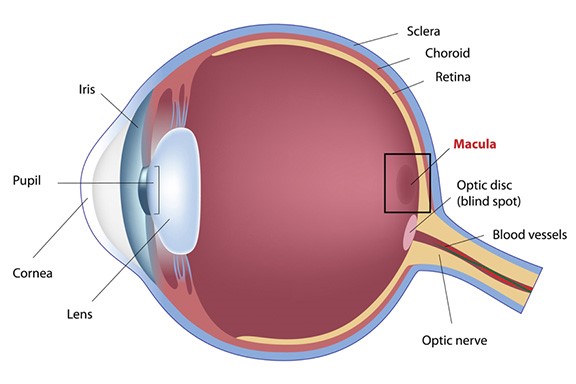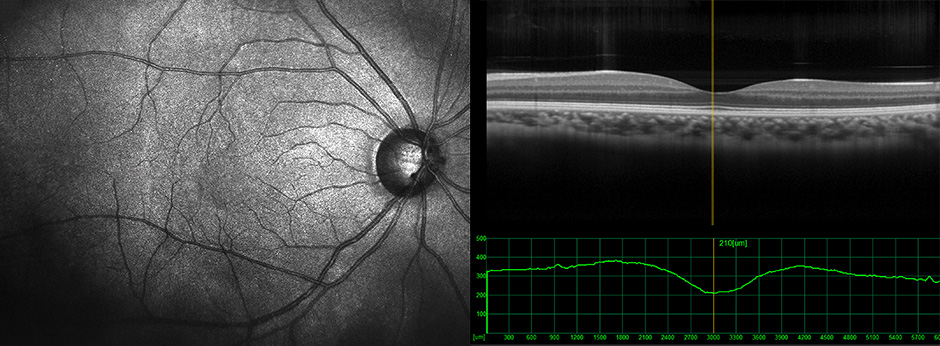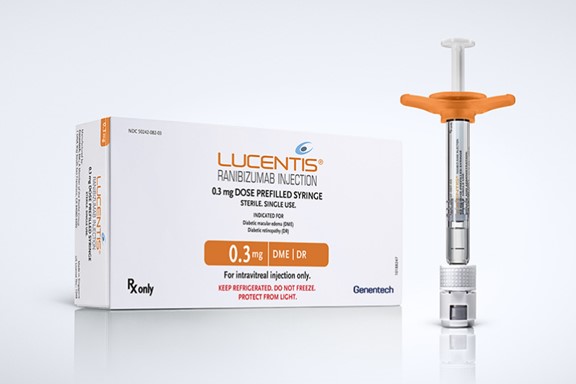Age-related Macular Degeneration
First things first, what is your macula?
Your macula is the 'sweet spot' in your vision. Right in the centre of your retina, it is the place where you have your best vision. It is the area on which your eye focuses what it sees.
For all its importance, the macula is tiny. The size of a pinhead, containing a few million specialised photoreceptor cells called cone cells. These cone cells work best in bright light and allow you to see fine detail for activities like reading and writing and recognising colours. When someone develops Age-related Macular Degeneration (AMD), it is the cone cells in the macular area that become damaged and stop working as well as they should.
So the macula, that small area on your retina, is very important.

The peripheral retina outside the central area is mostly made up of the other type of photoreceptors called rod cells. They allow us to see when light is dim and provide peripheral vision. AMD does not affect the peripheral retina, meaning that side vision remains good. AMD does not cause you to lose all your sight.
Who gets AMD and why?
There is no obvious or single cause for AMD.
- Age: while it’s most often seen in those aged over 65, it can also develop in people who are any age.
- Gender: more women have AMD than men, although this may be due to slightly longer life expectancy in women.
- Genes: there certainly seems to be a familial tendency towards AMD. However, not all AMD is thought to be inherited.
- Smoking: increases your risk of developing AMD – it is hard to find anything bad that smoking doesn't make worse.
- Sunlight: a life spent with exposure to high levels of sunlight may be a factor.
- Food: maybe, there isn’t an agreement on how much of a risk factor diet can be.
So, wear sunglasses, eat a balanced diet with plenty of fresh fruit and vegetables and stop smoking.
Although, the evidence for the above is limited, but you'll feel better and be healthier.
What should I look out for?
AMD creeps up on you gradually, early signs are easily overlooked but usually the first thing you’ll notice is that it’s harder to see detail, such as small print. You may find that your vision has a small blurred area in the centre. Straight lines may look distorted or wavy, or like there’s a little bump in them. You may also find that you’re more sensitive to bright light.
Types of AMD
As with nearly all medical conditions, there are variations with important differences. You may already have heard the terms 'wet' and 'dry' macular degeneration.
Dry AMD
This is the more common type of AMD. It develops very slowly and causes a gradual change in your central vision. Dry AMD usually takes a long time – sometimes years, to get to its final stage. At its worst, dry AMD causes a blank patch in the centre of your vision in both of your eyes. It doesn’t affect your peripheral vision, so it never leads to total blindness.
Wet AMD
About 10 to 15 per cent of people who develop AMD go on to develop wet AMD. This is when the cells of the macula stop working correctly and your eye starts growing new blood vessels to fix the problem. As these blood vessels grow in the wrong place, they cause swelling and bleeding underneath the macula – this is why it’s called “wet” AMD.
The name for this blood vessel growth is neo-vascularisation. It causes more damage to your macula and eventually leads to scarring – accelerating the damage to your sight.
Wet AMD can develop very quickly, causing serious changes to your central vision in just days or weeks. Treatment is available for wet AMD, which stops the new blood vessels from growing and damaging your macula. This treatment needs to be given before the new blood vessels do too much damage to your macula. If the blood vessels are left to grow, the scarring and the sight loss they cause is usually permanent. Wet AMD doesn’t affect your peripheral vision, so it doesn’t lead to total blindness.
Wet & Dry AMD
Wet and dry AMD have a few things in common. They usually affect both your eyes and won’t affect your peripheral vision. Neither type of AMD will cause you to lose all your sight.
Some people may have wet AMD in one eye and dry AMD in the other, which doesn’t develop into wet AMD.
AMD is not painful and it never leads to a complete loss of vision. Most people with AMD keep their peripheral vision, which means that you should still be able to get around on your own and make use of this vision every day.
Some people who have lost a lot of vision because of AMD or another eye condition may experience visual hallucinations – they may see shapes, colours or figures that aren’t really there. This condition is known as Charles Bonnet syndrome (CBS).
Diagnosing AMD
The early signs of AMD are often picked up before you really notice any visual changes. It is one of the things that here at Hampshire Eye Consultant are looking out for in regular eye examinations.
The beginnings of dry AMD may just require careful monitoring. We may take images of your retina to monitor any changes.
We examine your macula using a special microscope called a slit lamp top look into your eye and a special magnifying ‘fundus’ lens to examine the macula in detail. To help them see all the retina, you'll be given eye drops to dilate your pupil. This can feel a bit odd and affect your vision, so don't under any circumstances drive yourself to or from this appointment.

Optical Coherence Tomography
An OCT is a scan that shows a cross section image of the retina, giving a detailed picture of your macula. This helps us find out how much fluid is in your macula, to see if your macula is thicker than it should be and to check for any signs of changes.
You’ll need to have some drops to dilate your pupil before the scan. You’ll then be asked to sit in front of the OCT machine, look at a light and keep still while your eye is scanned by the machine. It’s a painless and very quick procedure, which doesn’t involve any physical contact with your eye, and it only takes a couple of minutes to complete.

Treating Dry AMD
Despite decades of research, we still don't have an effective treatment for dry AMD. However, there are always trials in progress and it is to be hoped that the situation will change over the next few years.
There’s some evidence that high doses of vitamin A, C, E, the minerals zinc and copper and the micro nutrient lutein when taken together may help slow down the progression of dry AMD, particularly if AMD has already caused vision changes in one eye. However, there is no evidence that taking high doses of these vitamins can prevent you from developing AMD in the first place.
Treating Wet AMD
Anti-VEGF
The primary treatment for wet AMD is a group of medications called anti-vascular endothelial growth factor (anti-VEGF) drugs. As new blood vessels form in your eye, your body produces a chemical which encourages further new blood vessel growth. Anti-VEGF drugs interfere with this chemical and stop the vessels from growing, preventing further damage to your sight.
The medication has to be injected into the vitreous inside your eye. This is called an intravitreal injection. This injection needs to be given in an operating theatre or a “clean room” to avoid infection.
Before the injection, you’ll be given anaesthetic eye drops to make your eye numb and an antibiotic drop to help prevent you from getting an infection.
The sight in your treated eye may be blurry for a day and you may notice a small black circle in the lower part of your vision. This is caused by a small air bubble, which will disappear after a few hours.
Normally, a course of three injections, one a month for three months, is given to start with. Once you’ve had these three injections, your eyes will be checked at the hospital every four to eight weeks.
There are different types of anti-VEGF medications and each may require different monitoring schedules.

Anti-VEGF treatments have a high success rate and in most cases, they stop your sight from getting worse. Up to 40 per cent of people may also see an improvement in their vision.
However, it is important to remember that the main aim of anti-VEGF treatments is to control the swelling and bleeding under the macula by stopping the growth of new blood vessels. It cannot repair any underlying damage that may already be there, which is why you should start your treatment for wet AMD as soon as possible. We can help arrange this with colleagues in the private or NHS sector.
FAQs
If you experience blurring or distortion of your central vision, and would like an honest, friendly and professional opinion, contact us using the form provided, via email info@privateophthalmologist.co.uk or call 07949 767906. These symptoms can happen in other conditions and we can guide you to the most appropriate care.
Quality care in a relaxing surrounding
Book an appointment to see Mr Nish Srikantha at the Candover clinic in Basingstoke, or the Healthshare Clinic in Winchester.
Both locations are modern purpose built private hospitals designed entirely for patient well-being and comfort. The Candover Clinic is a stand-alone unit located on the Basingstoke and North Hampshire Hospital. The Healthshare Clinic on the outskirts of Winchester boasts a purpose built ophthalmic outpatients department and operating theatre offering the latest diagnostic and treatment technologies.













